The Fabric Schism is Over: Why Your Next Move Should Be Towards Open Ethernet
The painful choice between proprietary performance and open economics is over. The fabric schism has ended. As performance equalizes, the overwhelming TCO and strategic advantages of open Ethernet make it the only logical path forward for AI at scale.

We've reached the end of our journey through the heart of the AI factory. We started by defining the network as the AI factory's nervous system. We paid our respects to the reigning king, InfiniBand, and examined the gilded walls of its proprietary garden. We witnessed the great transformation of Ethernet, diving deep into the UEC's technical secret weapons and the critical role of the DPU. We mapped the battle lines of the vendor wars, calculated the real-world economics, and drew up a blueprint for a next-generation supercluster.
Now, it's time to draw the ultimate conclusion.
For years, building an AI cluster involved a painful choice, a fundamental schism in the networking world: Do you choose the absolute best performance, locked inside the expensive, proprietary InfiniBand ecosystem? Or do you choose the cost-effective, open, but technically inferior world of traditional Ethernet?
Today, that schism is over. The choice is no longer a choice. The paradigm has shifted, and the future is flowing decisively in one direction.
The Verdict: The Case for Open Ethernet is Now Overwhelming
The central argument of this series is that the historical trade-offs that defined AI networking are now obsolete. The Ultra Ethernet Consortium (UEC) and the technologies it has standardized are systematically neutralizing InfiniBand's performance advantages.
Let's summarize the case:
- The Performance Gap is Closed: By re-architecting the transport layer with a message-oriented, out-of-order fabric, UET's packet spraying and flexible delivery are designed to achieve performance parity with InfiniBand on the metric that truly matters: Job Completion Time.
- The Economic Case is Unbeatable: When performance is equalized, the decision framework shifts to Total Cost of Ownership. Here, open Ethernet's advantages are overwhelming. Its hyper-competitive, multi-vendor ecosystem drives down hardware costs, and its massive global talent pool dramatically lowers the operational cost and complexity of running the fabric at scale.
- The Strategic Risk is Eliminated: For the hyperscalers and large enterprises building the world's AI infrastructure, freedom from single-vendor lock-in is not a preference; it's a strategic imperative. Open, standards-based networking provides the supply chain diversity, pricing pressure, and long-term flexibility they demand.
The future AI network is a hybrid architecture. Ultra-high-bandwidth proprietary interconnects like NVLink will persist for the critical "scale-up" job of connecting GPUs within a server. But for the massive "scale-out" fabric that ties tens of thousands of servers into a single supercomputer, UEC-based Ethernet will be the undisputed standard.
Your Next Move: An Action Plan for the Open AI Era
For CTOs, VPs of Infrastructure, and the architects charting their organization's multi-billion-dollar AI strategy, the path forward requires a decisive shift in mindset. The time for waiting is over. Here are your next moves:
- Engage with the UEC Immediately. The Ultra Ethernet Consortium is no longer a speculative body; it is the primary organization defining the future of AI networking. Active monitoring of the UEC's roadmap is now mandatory. This provides critical insight into technology directions and ensures your internal strategy aligns with the industry consensus.
- Shift Your Evaluation Criteria. Stop relying on simplistic latency microbenchmarks. Your primary metric must be performance-adjusted TCO, using real-world Job Completion Time for your specific workloads. The winning fabric is the one that delivers the most completed jobs per dollar, over the entire lifecycle.
- Architect for a Hybrid Interconnect Future. Design your future clusters around the hybrid model. Acknowledge the role of proprietary links for scale-up, but architect your massive scale-out fabric exclusively around open, UEC-compliant Ethernet. Your vendor choices for compute and networking should be heavily weighted by their commitment to this open model.
- Mandate DPU-based Endpoints. For any new large-scale cluster, specify DPU-based network interfaces as a baseline requirement. The infrastructure offload, security isolation, and performance gains they provide are no longer optional; they are foundational to any efficient and secure AI cloud.
- Pilot UEC Hardware Aggressively. As the first wave of UEC 1.0-compliant switches and NICs becomes available, you must begin pilot programs immediately. The goal is to independently validate performance claims, build internal operational expertise, and de-risk your future large-scale deployments.
In this new era, the greatest risk is not in adopting the new open standard. The greatest risk is being the last one left behind, locked inside the walls of the old proprietary one. The fabric schism is over. It's time to make your move.



